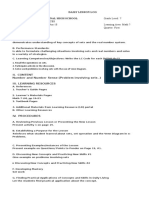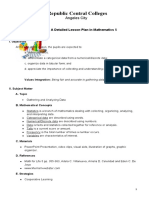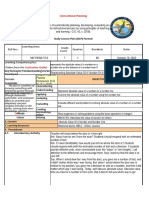Production of Classroom Management Routine and Materials To Be Used During Cooperative Learning Structure
Production of Classroom Management Routine and Materials To Be Used During Cooperative Learning Structure
Uploaded by
Mary Ann M. MingoOriginal Description:
Original Title
Copyright
Available Formats
Share this document
Did you find this document useful?
Is this content inappropriate?
Report this DocumentCopyright:
Available Formats
Production of Classroom Management Routine and Materials To Be Used During Cooperative Learning Structure
Production of Classroom Management Routine and Materials To Be Used During Cooperative Learning Structure
Uploaded by
Mary Ann M. MingoCopyright:
Available Formats
PRODUCTION OF CLASSROOM MANAGEMENT
ROUTINE AND MATERIALS TO BE USED DURING
COOPERATIVE LEARNING STRUCTURE
Classroom Management to Richard Kellough(2003) is the process of
organizing and conducting a classroom to maximize learning. It involves the
teachers action to create a learning environment that encourages positive social
interaction, active engagement in learning, and self-motivation (Burden &Byrd,
2003). Likewise it involves the establishment and maintenance of the classroom
environment so that educational goals can be accomplished (Moore, 2005).
Perspective on Classroom Management
Arends(2004) presents below the ideas that can provide additional
perspective on classroom management.
1. Classroom management is possibly the most challenge facing teachers. A
teachers reputation among colleagues, schools authorities and students will
be strongly influenced by his or her ability to perform the managerial
functions of teaching, particularly creating and orderly learning environment
and dealing with student behavior.
Classroom challenges are one of the adequate problems faced by teachers
and a good teacher has the courage to overcome all these challenges bravely.
2. Classroom management and instruction are highly interrelated. Classroom
management is not and end in itself. It is merely one part of a teachers overall
leadership role. In this regard, classroom management cannot be separated
from the other aspects of teaching. This refers to preventive management, the
perspective that many classroom problems can be solved through good
planning, interesting and relevant lessons, and effective teaching.
Elements of Effective Classroom Management
Effective classroom management is the touchstone of effective
instruction. Daniel Mujis and David Reynolds (2005) identified the elements that
have bearing in the conduct of managing the classroom such as the following:
1. Starting the lesson. The start of the lesson can involbe several classroom
management difficulties that the teachers need to take into account like
prime lessons running late, playtime going on too long, or ineffective
management of students going out of the classroom.
2. Appropriate seating arrangement. Students need to have sufficient space to
comfortably. If movement in the class is desired or necessary, students should
be able to do this easily and without them pushing or shoving one another for
space.
3. Dealing with external disruptions. The teacher needs to make sure that
interruptions cause minimum disruption to the lesson by having clear rules for
students behavior such disruption and by dealing with them quickly.
4. Establishing class rules and procedures. One of the main factors in ensuring
that lessons run smoothly is the establishment of clear rules and procedures
from the start. Rules and procedures need to be actively taught to students in
order to work.
5. Smooth transition between lesson segments. One of the main was to ensure
that maximum time is given to each task is to avoid wasting too much time
during transition from one part of the lesson to the next. Transition should be
as short and smooth as possible. Teachers should establish clear procedures
for lesson transition.
6. Student talk. Inappropriate student talk can disrupt lessons. Students talking
during the lesson are off tasks themselves and can distract other pupils. Clear
rules on when student talk or is not allowed are important.
7. Giving homework/assignments. Effective teachers give assignments
immediately following related in-class activities. It is important that teachers
make I clear that homework is essential and not just an obligatory time – filler.
Homework should not be used or presented as punishment.
8. Maintaining momentum during the lesson. One of the most fruitful ways of
preventing student misbehavior during lesons is to ensure the smooth flow of
the lesson.
9. Downtime. This refers to those parts of the lesson during which one or more
students have time to fill because they have finished seatwork early. This
situation easily leads to disruptions if clear procedures are not addressed by
teachers at all.
10.Ending the lesson. Problems that can occur at the end of the lesson include
not leaving enough time for finishing the planned activities, lesson running
over time, and instructions for homework getting lost as student rush to
collect their belongings and go off for lunch or playtime.
Benefits in the Classroom
There are many benefits that can result from using cooperative learning
strategies. Here are benefits you might notice after implementing cooperative
learning tasks in your classroom:
1. Cooperative learning is fun, so students enjoy it and are more motivated.
2. Cooperative learning is interactive, so students are engaged, active
participants in the learning.
3. Cooperative learning allows discussion and critical thinking, so students
learn more and remember what they've learned for a longer period of time.
4. Cooperative learning requires students to learn to work together, which is an
important skill for their futures.
10 Tips to Implement Cooperative Learning in your Classroom
Cooperative Learning is a great tool to use in your classroom. Cooperative
Learning helps students be able to communicate effectively with others, work
well with others, and have some responsibilities in your classroom. Using
Cooperative Learning will help your students become more engaged in what you
are teaching.
1. Groups of 4
Groups of 4 is the best way for students to be able to work with others, but it’s not too
much for a group discussion. I think 4 is a wonderful group size, perfect to pair off or
work as a whole group.
2. Numbering Students
This really helps the whole class flow well. being able to say a number and they
can answer the question, or go to do something.
3. Rank the Students
4. Color or Number Groups
5. Use a spinner
6. Use a Timer
7. Use Structures
8. Utilize Talking and Group Work
9. Build Up Teams
10.Use Gambits
These tips will help the teachers to implement Cooperative Learning in their classroom. Cooperative
Learning will make your teaching better and engages your students more.
You might also like
- Centennial Program GuideDocument2 pagesCentennial Program GuideWræn ŸåpNo ratings yet
- Graphic OrganizerDocument3 pagesGraphic OrganizerAzlina MohamedNo ratings yet
- School Grade LevelDocument4 pagesSchool Grade Levelrina galayNo ratings yet
- I. Learning Objectives: Ivie O. Cabural Bsed Mathematics 3 YearDocument3 pagesI. Learning Objectives: Ivie O. Cabural Bsed Mathematics 3 YearBingkay CaburalNo ratings yet
- Gen Ed Math 2 PnuDocument62 pagesGen Ed Math 2 PnuFobe Lpt NudaloNo ratings yet
- Criteria Points/Scores 5 4 3 2 1 Knowledge On The Subject MatterDocument2 pagesCriteria Points/Scores 5 4 3 2 1 Knowledge On The Subject MatterMichelle M. BagoNo ratings yet
- Semi-Detailed LP - Operation On MonomialsDocument2 pagesSemi-Detailed LP - Operation On MonomialsJohn Paul Miranda0% (1)
- WEEK 3 Understanding CLSDocument41 pagesWEEK 3 Understanding CLSPrimaNo ratings yet
- Slope LPDocument4 pagesSlope LPEmman SanoNo ratings yet
- Mathematics Module TemplateDocument8 pagesMathematics Module Templatecharie ventanillaNo ratings yet
- DLP 3Document2 pagesDLP 3Pablo JimeneaNo ratings yet
- Mathematics: Quarter 3 - Module 4Document20 pagesMathematics: Quarter 3 - Module 4Cillian ReevesNo ratings yet
- Effectiveness of Jigsaw Cooperative Learning Strategy in Solving Quadratic EquationDocument14 pagesEffectiveness of Jigsaw Cooperative Learning Strategy in Solving Quadratic EquationCedie YganoNo ratings yet
- FIELD STUDY 1 Episode 6Document7 pagesFIELD STUDY 1 Episode 6RylNo ratings yet
- School Grade Level Teacher Learning Area Teaching Date and Time QuarterDocument3 pagesSchool Grade Level Teacher Learning Area Teaching Date and Time QuarterJessie OlantigueNo ratings yet
- M7NS Ib 2Document4 pagesM7NS Ib 2jennelyn malaynoNo ratings yet
- FuturesDocument59 pagesFuturesMikhaela Pabinguit50% (2)
- Does The Student Trust EasilyDocument2 pagesDoes The Student Trust EasilyAthena MaderaNo ratings yet
- Pre-Test On Addition and Subtraction of Polynomials: Name: Date: Grade 7 - Score: Choose The Letter of The Best AnswerDocument1 pagePre-Test On Addition and Subtraction of Polynomials: Name: Date: Grade 7 - Score: Choose The Letter of The Best AnswerJolly Ann CapalarNo ratings yet
- IV-Day 9Document4 pagesIV-Day 9Nicole TanyagNo ratings yet
- Performance Task 3 Factors Affecting Problem SolvingDocument2 pagesPerformance Task 3 Factors Affecting Problem SolvingRegine HufanciaNo ratings yet
- Daily Lesson Log of M7Ge-Iiij-1 Day 4 (Week One-Day 4)Document3 pagesDaily Lesson Log of M7Ge-Iiij-1 Day 4 (Week One-Day 4)Zile SmithNo ratings yet
- Internship Reflection JournalDocument12 pagesInternship Reflection Journalapi-357369904No ratings yet
- FS 1 - Episode 6Document5 pagesFS 1 - Episode 6Bhabierhose Saliwan LhacroNo ratings yet
- FS 1 Ep. 3 DoneDocument15 pagesFS 1 Ep. 3 DoneRylNo ratings yet
- DLL - Quarter 1 (Patterns and Algebra)Document2 pagesDLL - Quarter 1 (Patterns and Algebra)tee jay ramosNo ratings yet
- Semi Detailed Lesson Plan FINALDocument5 pagesSemi Detailed Lesson Plan FINALNathalie CordialNo ratings yet
- Math 7 DLPDocument6 pagesMath 7 DLPJennymae CulalabeNo ratings yet
- Why CRADocument3 pagesWhy CRANur NadzirahNo ratings yet
- A Detailed Lesson Plan AlgebraDocument5 pagesA Detailed Lesson Plan AlgebraJohn Mark Amante DumalaganNo ratings yet
- FIELD STUDY 2 (Episode 2)Document5 pagesFIELD STUDY 2 (Episode 2)Jerico Padilla NuestroNo ratings yet
- FS 106 Episode 1-5Document9 pagesFS 106 Episode 1-5Rachel BroditNo ratings yet
- Fs 1 Episode 5,6Document9 pagesFs 1 Episode 5,6Vîctory Singao WaclinNo ratings yet
- FS 1 Episode 9Document4 pagesFS 1 Episode 9JELLY LULABNo ratings yet
- Lesson Plan 2Document3 pagesLesson Plan 2api-281594404100% (1)
- Week 2Document12 pagesWeek 2Ederzon IlustricimoNo ratings yet
- Detailed Lesson Plan Grade 8 - Mathematics: M8Al-Iic-1Document6 pagesDetailed Lesson Plan Grade 8 - Mathematics: M8Al-Iic-1kat castilloNo ratings yet
- Pinagtonulan Integrated National High SchoolDocument8 pagesPinagtonulan Integrated National High SchoolAngela CatainaNo ratings yet
- M7Sp-Ivd-E-1: Bilbao-Uybico National High SchoolDocument3 pagesM7Sp-Ivd-E-1: Bilbao-Uybico National High SchoolRed CruzNo ratings yet
- Sample of A Detailed Lesson Plan in MathDocument9 pagesSample of A Detailed Lesson Plan in MathMartha MendozaNo ratings yet
- Angle of Elevation and DepressionDocument9 pagesAngle of Elevation and DepressionMia ButiongNo ratings yet
- George Polya (1887 - 1985)Document18 pagesGeorge Polya (1887 - 1985)Yu ChuanNo ratings yet
- Grade 9 Lesson PlanDocument17 pagesGrade 9 Lesson PlanSamuel BaunNo ratings yet
- Semi-Detailed Lesson Plan For Grade-7 Mathematics Prepared By: Jennelyn G. Malayno ObjectivesDocument2 pagesSemi-Detailed Lesson Plan For Grade-7 Mathematics Prepared By: Jennelyn G. Malayno Objectivesjennelyn malaynoNo ratings yet
- DLP Math 7 10-18-22Document3 pagesDLP Math 7 10-18-22FairyLeen PitogoNo ratings yet
- Educ TechDocument3 pagesEduc TechTeodoro Jr de Jesus100% (1)
- IV-Day 39Document4 pagesIV-Day 39Florita LagramaNo ratings yet
- FS 1and2 DTR TemplateDocument1 pageFS 1and2 DTR TemplateCanonoy, Jemina Camille L.No ratings yet
- Session Guide For Real NumbersDocument5 pagesSession Guide For Real NumbersFelix LlameraNo ratings yet
- JocellpDocument19 pagesJocellpapi-263108409No ratings yet
- Domain 1Document42 pagesDomain 1DANDY DUMAYAONo ratings yet
- Mathematics: Simplifying Rational Algebraic Expressions - M8AL-Ic-2Document13 pagesMathematics: Simplifying Rational Algebraic Expressions - M8AL-Ic-2ROMEO JR RAMIREZNo ratings yet
- FS Le 15.Document7 pagesFS Le 15.Bon Ivan FirmezaNo ratings yet
- Inventory of Sample Action Research Conducted by TeachersDocument3 pagesInventory of Sample Action Research Conducted by TeachersKimberly De Vera-Abon100% (1)
- Samples of Supporting Student ActivitiesDocument14 pagesSamples of Supporting Student ActivitiesMaria MabutiNo ratings yet
- Field Study 2-Le 1-2Document10 pagesField Study 2-Le 1-2Cherryl SiquigNo ratings yet
- Field Study 1.5: Creating An Appropriate Learning EnvironmentDocument10 pagesField Study 1.5: Creating An Appropriate Learning EnvironmentAngelu Dalida SanchezNo ratings yet
- Lesson Plan in Mathematics IVDocument3 pagesLesson Plan in Mathematics IVVanessa Lorraine Santos-De LeonNo ratings yet
- A Detailed Lesson Plan - OmongayonDocument12 pagesA Detailed Lesson Plan - OmongayonREYNAN REY OMONGAYONNo ratings yet
- Organization and Management of Teaching and Learning-EDU 412Document10 pagesOrganization and Management of Teaching and Learning-EDU 412bello fatimaNo ratings yet
- Section 2 Professional Teachers Are Competent Chapter 4Document29 pagesSection 2 Professional Teachers Are Competent Chapter 4Carmelli Ann GallardoNo ratings yet
- Lesson Plan Objective Key Month 6 Week 2 Lesson 2: Unit 15: The World of Work 15.1. Working HoursDocument2 pagesLesson Plan Objective Key Month 6 Week 2 Lesson 2: Unit 15: The World of Work 15.1. Working HoursTrương Ngọc Lệ QuyênNo ratings yet
- Department of Education Mail - COMPETENCY-BASED TRAINING NEEDS ASSESSMENT CHECKLIST-CBTNA FOR TEACHERSDocument6 pagesDepartment of Education Mail - COMPETENCY-BASED TRAINING NEEDS ASSESSMENT CHECKLIST-CBTNA FOR TEACHERSMichelle Manuel Sioson-GatchalianNo ratings yet
- Flouts of The Cooperative Principle MaxiDocument14 pagesFlouts of The Cooperative Principle Maxiann de leonNo ratings yet
- WIFI DefinationDocument2 pagesWIFI Definationamol0037No ratings yet
- Posters August Format 2Document16 pagesPosters August Format 2juliangrenierNo ratings yet
- Medical Health Care PowerPoint TemplatesDocument48 pagesMedical Health Care PowerPoint TemplatesRomanNo ratings yet
- Concepts of CommunicationDocument15 pagesConcepts of CommunicationTanzeel Khan0% (1)
- List Down The Different Classification Rating Used in Television and Film A. Movie Classification RatingsDocument1 pageList Down The Different Classification Rating Used in Television and Film A. Movie Classification RatingsMenggay100% (1)
- Iimc Apmp BrochureDocument14 pagesIimc Apmp Brochurepizza nmorevikNo ratings yet
- DaknetDocument18 pagesDaknetVamshi RathodNo ratings yet
- Ruijie RG Ap180 Wireless Access Point Datasheet 2020.11.23Document12 pagesRuijie RG Ap180 Wireless Access Point Datasheet 2020.11.23Jody iOSNo ratings yet
- Dedicated Laundry App: The Key Stakeholders in The Process Are The Rinser, The Delivery Personnel, and The UserDocument4 pagesDedicated Laundry App: The Key Stakeholders in The Process Are The Rinser, The Delivery Personnel, and The Usermark moslehNo ratings yet
- Alarcon y Nauhuelcheo - Creencias Sobre El Embarazo, Parto y Puerperio en La Mujer MapucheDocument15 pagesAlarcon y Nauhuelcheo - Creencias Sobre El Embarazo, Parto y Puerperio en La Mujer MapuchePablo HerrazNo ratings yet
- Limba CamunicaDocument6 pagesLimba CamunicatarnawtNo ratings yet
- EDA 04 - ACTIVITY 04 1st Sec OkDocument4 pagesEDA 04 - ACTIVITY 04 1st Sec OkMilagros CherrezNo ratings yet
- Memos: Classification, Purpose, Structure, Layout, StyleDocument22 pagesMemos: Classification, Purpose, Structure, Layout, StyleMinahil MehdiNo ratings yet
- Teste Pe TestDocument40 pagesTeste Pe TestINformai hkdskdhNo ratings yet
- HHS Public Access: Caregiver, Patient, and Nurse Visit Communication Patterns in Cancer Home HospiceDocument17 pagesHHS Public Access: Caregiver, Patient, and Nurse Visit Communication Patterns in Cancer Home HospiceRatih puspita DewiNo ratings yet
- Instructional-DesignDocument14 pagesInstructional-DesignTijana BrzićNo ratings yet
- Remediation LogDocument4 pagesRemediation LogAugust DelvoNo ratings yet
- 11 Scopus Digital Marketing Through Social Networking Sites Digital Marketing Through Social Networking SitesDocument3 pages11 Scopus Digital Marketing Through Social Networking Sites Digital Marketing Through Social Networking SitesBalathandayutham PNo ratings yet
- Presentation On Marketing MixDocument11 pagesPresentation On Marketing MixTriciaGay DaleyNo ratings yet
- Commercial AnalysisDocument3 pagesCommercial Analysisapi-528796259No ratings yet
- G2 Session 7 Enhancing Listening and Responding SkillDocument14 pagesG2 Session 7 Enhancing Listening and Responding SkillCyrus ArmamentoNo ratings yet
- What I KnowDocument6 pagesWhat I KnowMariam GamosNo ratings yet
- LS 6 - ICT Not DoneDocument2 pagesLS 6 - ICT Not DoneClara Mae AntiquisaNo ratings yet
- Wireless Communication Unit I Anna UniversityDocument36 pagesWireless Communication Unit I Anna UniversityMr.A.Sriram Asst. ProfNo ratings yet
- TEAL Center Fact Sheet No. 8: Effective Lesson Planning: Access Resources For State Adult Education StaffDocument6 pagesTEAL Center Fact Sheet No. 8: Effective Lesson Planning: Access Resources For State Adult Education StaffKimberly Jamili MiayoNo ratings yet
- Radiomuseum Radio Craftsmen c400 10 Watt Audio Amplifier 474127Document2 pagesRadiomuseum Radio Craftsmen c400 10 Watt Audio Amplifier 474127ditgh ditghNo ratings yet

























































































